Processing of Puer Tea
The method of making tea is largely the same for all types of tea, with some variations; one tea is wilted, another not. One is bruised another not, one is steamed, another roasted. These differences, however small they may seem result in a wide range of teas that vary considerably in their taste, appearance and properties.
Both raw or sheng/生 Puer and cooked or shu/熟 Puer start out in the same way. But a typical difference is that cooked Puer is rarely made from ancient or old tea tree leaves. Raw Puer is also not always made from old tree tea, but there is a greater likelihood of it. Furthermore, single mountain source shou cha is not thought to produce the best tea – a blend of maybe 3-5 different mountains creates a better, more rounded flavour. The maocha from which Puer is produced is made in the following manner;
Picking Tea Leaves
Leaves are picked – for the best tea, from ancient or old tea trees, but can come from any form of camelia sinensis assamica. The most prized tea leaves are single tips (dan ya/单芽 – single tip), followed by single tip and leaf (yi ya, yi ye/一芽一叶 – one tip, one leaf), single tip, two leaves (yi ya, er ye/一芽二叶) and then tip, three leaves (yi ya, san ye/一芽三叶). It is fairly rare to find one tip, four leaves, or more in Puer tea. Some of the best Puer however is made by tea farmers who may have been been picking tea for generations, but who do not single out say, ‘yi ya, yi ye‘ etc. when they are picking leaves. 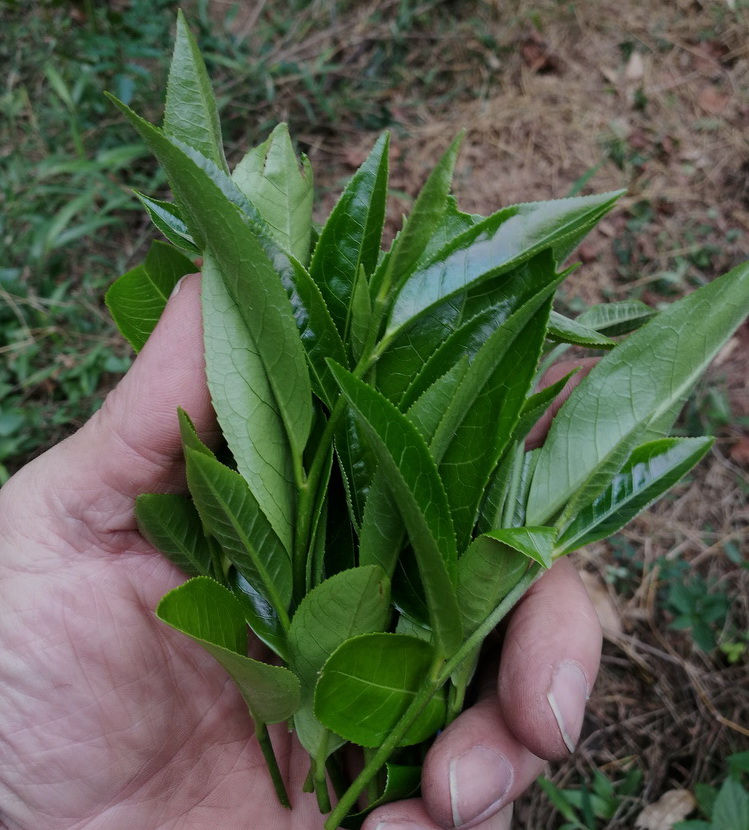
The result is that a lot of high quality Puer is a mix of the above formations, typically with tip and two leaf formations forming the majority. Trees that are less managed and growing in a more natural environment can often produce shoots with up to three leaves that can be processed without producing ‘huang pian‘. Because one of the aims of picking is to encourage new growth, the method of picking can also vary according to the age of the tree and the kind of new growth that the picker wishes to encourage. Older trees also need more time to recuperate and may well be picked less vigorously/frequently. Trees that are several hundred years old may only produce leaves twice a year.
Leaves are often collected in bags which the tea picker wears over one shoulder. This is practical, particularly where trees are on steep ground and when the picker needs to climb into a tree to gather leaves, but care needs to be taken not to compress the leaves since they may bruise easily and, if they remain like that for an extended period of time, they will start to ferment/oxidise. Ideally, if it is not practical for the farmer to return to the house in a relatively short period of time the leaves are transferred to a basket or spread out on mats.
There are varying practices, depending on local and individual habits, and also the distance of a farmer’s tea fields from the house. A few farmers will pick tea in the morning, then take it back to their house to wilt, fry, roll, and then sun dry but it is unlikely that the drying process can be completed in the same day, requiring further drying on the second day. This is not the traditional method of making Puer tea and few tea farmers work in this way. Many farmers live some distance from their tea fields so this approach is not practical so they will pick tea and bring it back to the house in the afternoon to fry and roll in the evening. In this case, the tea is kept after rolling and then put out to dry the next morning. Some tea makers spread the rolled tea out on bamboo mats ready for drying the next day, other keep the tea together, covered, and only the next day spread it out on mats for drying.
Tan Qing/ Wei Diao (Withering)
The next step is tan qing /摊青, laying the leaves out. The fresh leaves are laid out on bamboo mats at a depth of maybe 8-10 centimeters, traditionally in the area under the living quarters of a house where it is shaded and there is a little airflow. This step is most commonly referred as wilting or withering – weidiao/萎凋 – some people maintain that Puer tea is not wilted per se – the aim, nonetheless, is to reduce the moisture in the leaves (typically said to be about 10%) and for the moisture content to become more uniform between stems and leaves. The cell walls of the leaves also start to break down so the leaves become less brittle – i.e. so the leaves and stems don’t break when the tea is compressed a little in the hand; thus preparing it for ‘frying’. There is a gradual onset of enzymatic oxidation/fermentation. Proteins in the tea leaf will break down into amino acids, and other compounds such as caffeine are released. The effect of wilting tea for a longer time is to cause greater oxidation of the gallocatechins – into catechins and, if more extreme, into other compounds such as thearubigin, but Puer tea is not withered for such a long time. See here for more information on the effects of withering.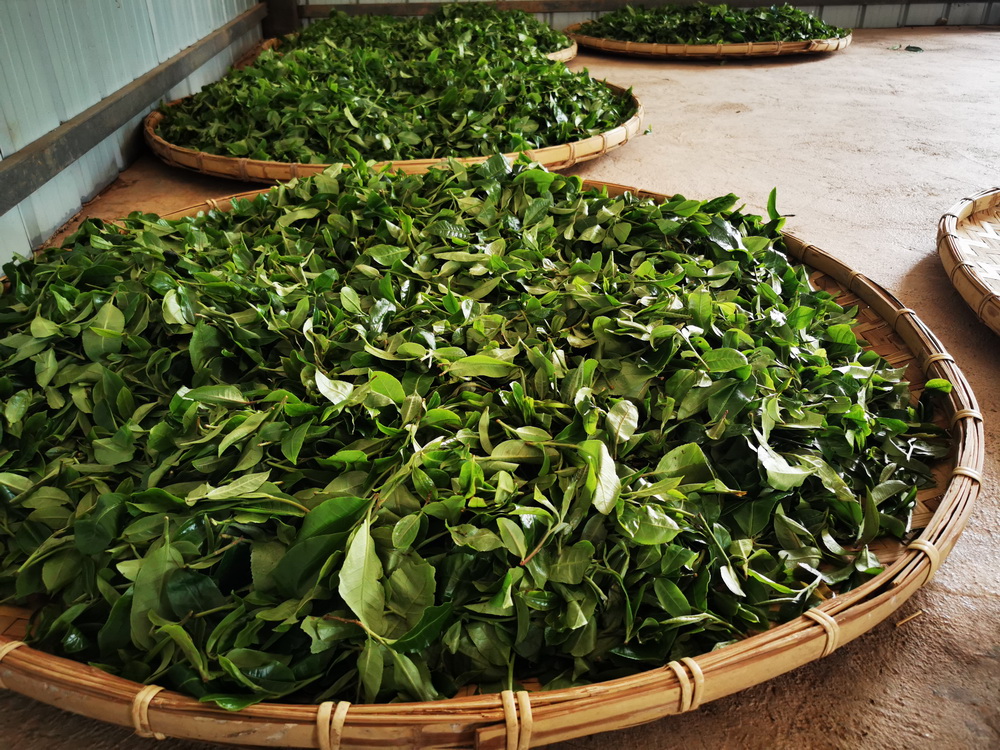
The ‘fresh grassy’ smell should have gone and the aromatic compounds in the tea become more prominent, typically producing more fruity,floral aromas. There should be no moisture apparent on the surface of the leaves. There is no specific time requirement for this part of the process as it varies according to the region, the moisture content in the leaves, the weather on the day, etc. The skill of the tea farmer in determining when the tea has wilted enough is critical. The effect of wilting for too short a time is to produce a Puer tea that has a stronger ‘sheng wei’/生味‘ which is not necessarily bad but makes the young tea less appealing to some people as it will also be more astringent and is often considered a sign of poor processing. If it’s not serious, it may well have little to no effect on the tea’s ageing potential. The effect of a longer wilting period is to produce a tea that is more strongly oxidised, and consequently a little less bitterness and astringency. If it is controlled well, this transformation is not per se detrimental to the tea and its ageing potential. If tea leaves are wilted for too long the tea will loose character and become a little weak/lacking in structure. A typical withering time for Puer is 2 to 4 hours.
Frying or Roasting Tea Leaves
The next stage is to roast or fry the tea. The aim of frying is to stop the enzymatic oxidation, further reduce the moisture content, and to bring out the fragrance in the tea. This process of sha qing /杀青 is translated as ‘killing green’.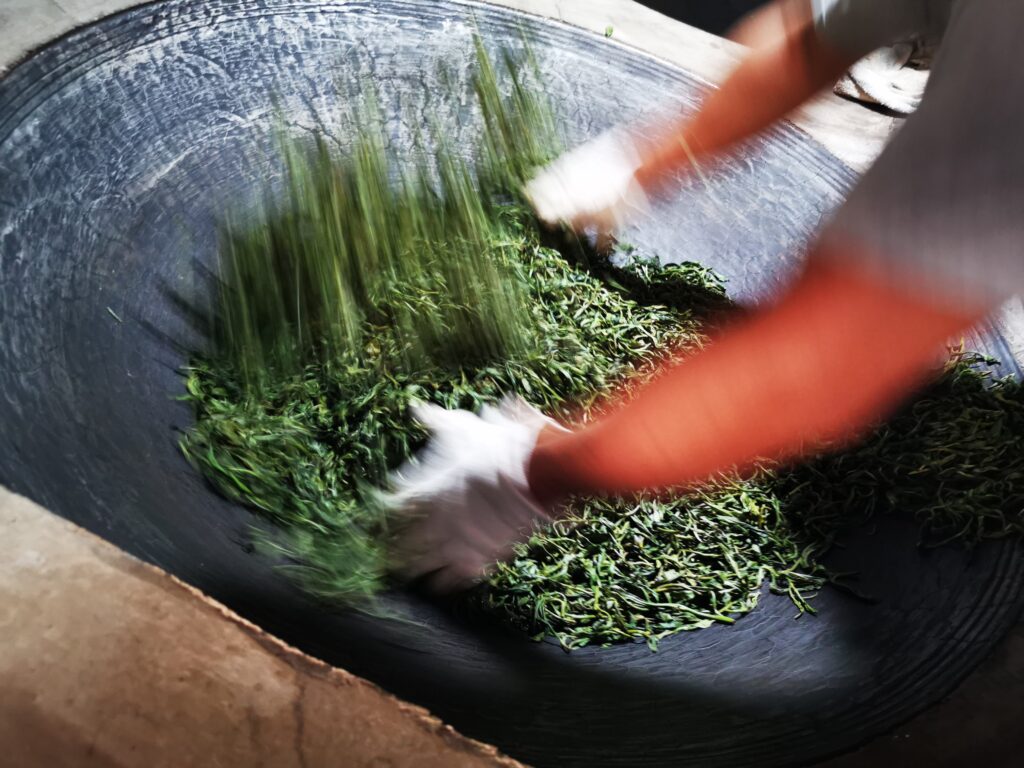
There are two basic kinds of wok used for frying tea that will produce Puer maocha/毛茶; flat or deep. A typical deep wok is 75 – 90 cm across and one, or often two are set on top of a brick-built oven that has separate wood fires for each wok and separate or shared flues. The wok is typically tilted slightly toward the front of the oven to allow better reach for the person frying the tea and to allow the tea leaves to naturally slide down toward the person processing the tea. In recent years there has been a trend for larger, heavier woks.
One understanding is the greater mass will help hold heat, but it also makes controlling the heat more critical. Recently, encouraged by government efforts to wean farmers off firewood, some villages have been turning to natural gas to fire the ovens, but it’s generally not popular.
The tea will typically reach temperatures of 80°C or so. If the temperature exceeds 90 degrees or so it will have a detrimental effect on the tea’s ageing potential. The degree of roasting should be controlled so that the moisture content is reduced to about 60-65%. People processing tea generally have no means to assess these factors other than sensory experience. So each day, each wok requires fine-tuning, if consistent, high quality tea is to be made.
The tea leaves are turned continuously using the hands and sometimes a wooden or bamboo two pronged fork. Some people wear a glove on one hand and use a fork with the other. About 5-6 kg of fresh leaves is normally fried in a wok of the size mentioned above. Scorched tea will produce a burned aroma, burned leaves. If roasted too lightly, the fragrance will be unsatisfactory and will cause some additional astringence.
There will also be more stems that have a reddish-brown colour because they were not properly processed and so continue to oxidise once taken out of the pan. This can produce an ‘oxidised’ aroma that may think is not ideal in Puer tea, but after some years of storage may well not be obvious.
Roasting tea to too high a temperature (say over ≈ 90 °C ) tends to produce a tea that has more ‘green tea’ like qualities, often with a ‘beaney’ kind of aroma, which may well impact the ageing process.
If the leaves are not lifted and turned enough, or too many are put in the wok at one time, it can also result in a poor quality tea with poor fragrance whereas turning/shaking out too much can dry the tea out before it’s ready. In extreme situations producing a tea that at the same time is ‘underdone’ and burned. It is a matter of fine judgement to decide when the leaves have been fried enough; this will depend on the particular leaves, the weather, the heat of the wok, etc.
There should be a distinct fragrance when sha qing is complete, The bright green colour of leaves should have turned to a deeper green. The leaves should feel quite sticky from the juices which have been produced by the leaves. The stems should not break when bent over, though thicker stems may still break if bent with force. It is also important with Puer tea that the enzymes are not completely destroyed by the sha qing process as they are critical to the later process of post-fermentation.
The aim of processing sheng puer is to bring out that particular tea’s qualities whilst keeping intact as much as possible of its original character. The more ‘processed’ it is, the less ‘natural’ it is. If tea from a particular area or tea garden is relatively bitter, then that’s the way it is. To attempt to deliberately reduce it’s bitterness is going to change its nature, and with skill, it may be possible to affect that within limits, but if it’s not done very skillfully and judiciously, it’s going to affect the tea’s ageing potential.
Previously, a cylindrical oven equipped with a revolving drum that was wood fired with a fan to blow hot air through it was sometimes used instead of hand frying, but this method was generally considered inferior to hand frying. Not least because the tea was put in at one end and came out of the other with no real means of controlling the time in most cases. The only parameters being the temperature and the rate of rotation of the drum.
In recent years more advanced designs have been brought into Yunnan including gas fired drums with a tipping mechanism and in the last few years another style of wok called ‘chao tian guo’/朝天锅‘ which is a little like a large cement mixer. The temperature in a mechanised wok or drum is likely to be a little higher than a wok and there is not the possibility of the same tactile or sensory judgement of when the tea is ready but more advanced machines allow for control of both temperature and time. Small tree Puer and summer tea is often fired using some kind of mechanical method as the tea’s value is not considered to be high.
After frying, the leaves are once again shaken out and spread out on mats at a depth of a few centimeters to cool for 10-20 minutes before rolling. The leaves need to be shaken out to help cooling and should not be rolled when hot.
Methods of Rolling Tea
As stated in Polyphenols in Puer tea a large amount of the active compounds in tea are in the cell walls. The purpose of rolling is to further release these substances which is beneficial to the flavour and also shapes the leaves. It is important that the rolling is not too heavy-handed as this will result in broken stems and leaves. The lustre on the leaves will also become subdued and they will lose some of their oiliness. If the rolling is too light , the fragrance will again be adversely affected, the flavour will be thin, the broth too light and the tea will be slow to steep. If the leaves are to be rolled twice they will be left a second time before the second rolling and then laid out on bamboo drying platforms to dry. Machine rolling is also quite common and many tea farmers have a rolling machine, but again, the results, whilst often pleasing to the eye, are less desirable than well hand-rolled Puer tea.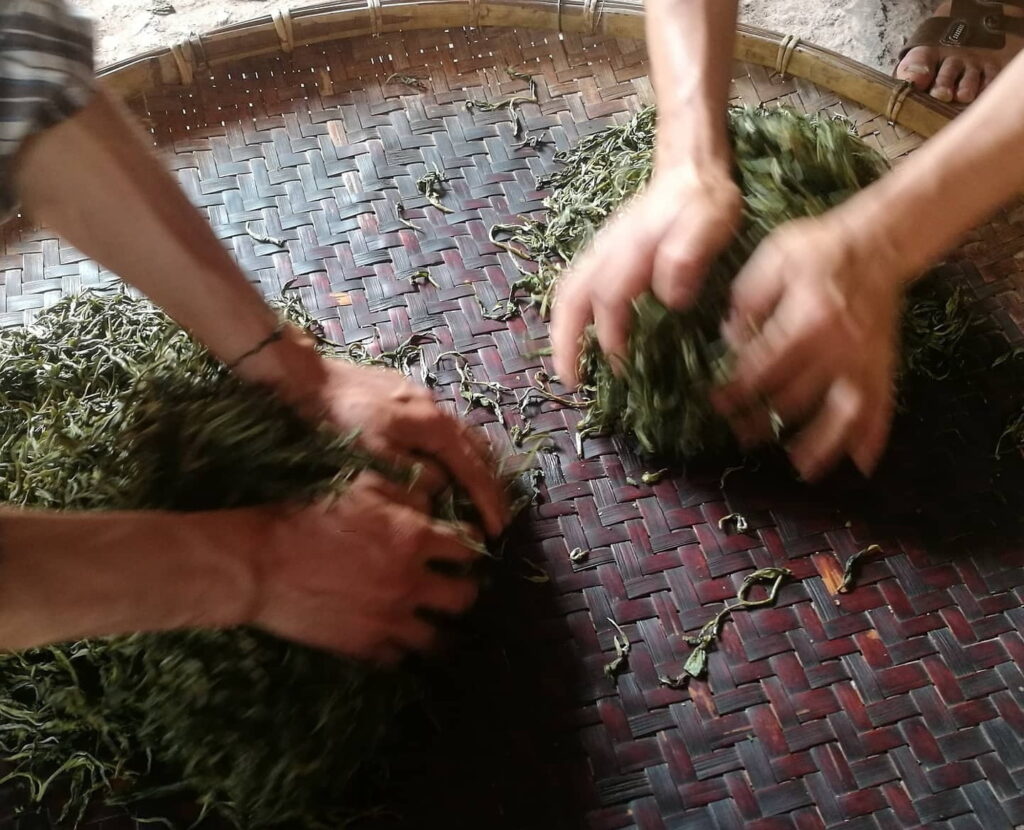
Drying Raw Puer Tea
After rolling, the tea is sun dried; shai qing /晒青. If the weather is not sunny, the leaves are air-dried, under a roof if necessary, bringing in yet another variable, but this method, though significantly inferior to sun drying is still superior to oven drying. According to current legislation, Puer tea has to be sun dried, but ovens are still prevalent, even in small villages, so it is difficult to rule out the possibility of oven drying if the weather is wet. See here for further detail on the importance of sun drying Puer.
The tea at this stage is referred to as mao cha and provides the raw material for pressing into sheng Puer cakes in various forms, or for making into cooked/shou Puer tea. Mao Cha can also be stored as loose leaf tea and aged. It is not uncommon for maocha to be stored loose for a year or two before pressing.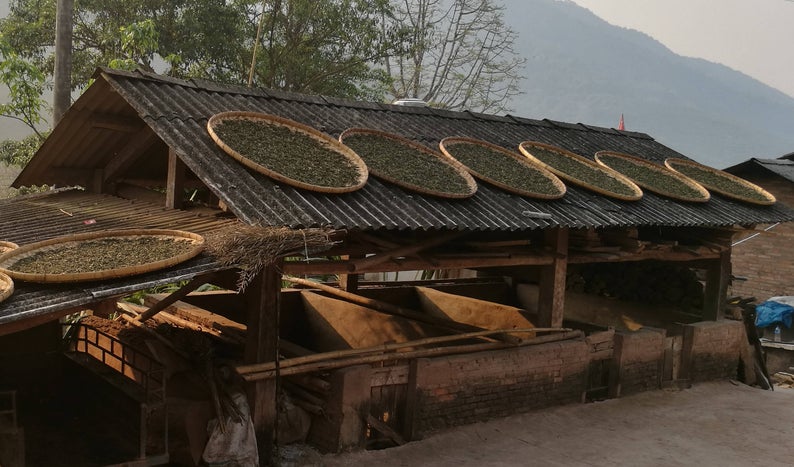
Raw/sheng Puer at this stage is ready for drinking, often having distinctive flavours in the young tea that mellow with age.
Pressing Puer Tea
The next step in the production of sheng Puer is pressing the loose leaves. For this, the tea is first weighed, steamed then, placed in a cloth bag. For cakes, it is fashioned into a round, discus form and placed on a wooden board for pressing. Traditionally, a heavy stone is used to compress the tea – normally with someone standing on the stone for a few seconds to aid compression. There are also a few hand operated pressing machines, but hydraulic machines are now very common in processing factories. (Some people use these hydraulic machines, set to apply a very light pressure, to ‘fix’ the shape of the cake, after which it is still put under a stone. Depending on the initial pressure, the second stage may be academic, but it is currently quite a common practice.)
After pressing for several minutes, the cake is removed, and then when cool, removed from the bag and put on a rack ready for drying. Drying is either natural or it is done in a low temperature oven – at a temperature of around 30-38°C. Drying can be done outside, but should not be in strong direct sunlight.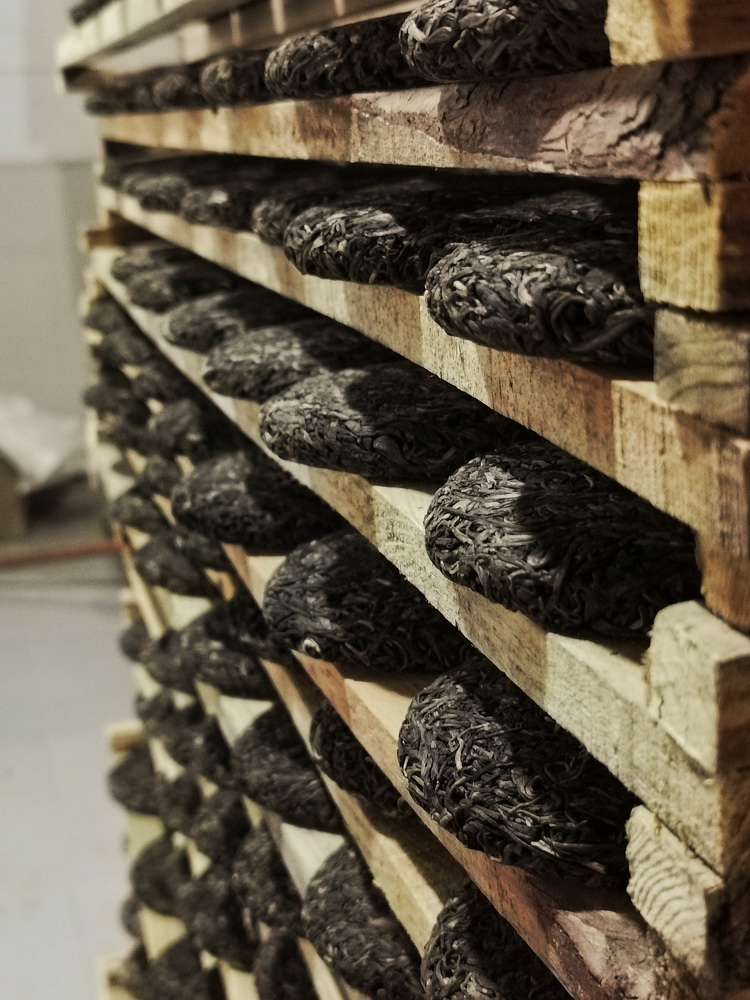
Hand pressed sheng Puer tea cakes are less compact than machine pressed; the amount of moisture remaining in the cake is greater and air can more readily penetrate the ‘hand-pressed’ cake so this affects the way the tea ferments, producing a different flavour. Stone pressed cakes are generally considered superior for these reasons though trends vary, and some people prefer tighter pressed cakes as they are thought to preserve their fragrance for longer.
Modern Puer tea bricks are generally machine pressed, so even if the same tea leaves are used to make a brick and a cake, after some years, a raw brick Puer will still appear greener, younger than the cake because the degree of compression is much greater.
Now the tea is ready to be drunk or aged. Because the enzymes and other bio-active compounds in the tea are largely still in tact, it will transform over time, gradually shedding some of its youthful qualities to develop other, more mature, aromas and characteristics.
To read a blog post with a more detailed discussion on some of the issues to do with processing Puer tea see here and here.
